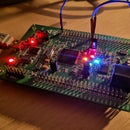Introduction: Guide to Neopixel
Hey, makers and LED enthusiasts!
I’m back with another fun project that has an interesting story behind it.
I knew about these Neopixel LEDs for a long time but never go round buying and using them. So one day, I purchased single LED modules from Ebay and used them for a while. There were only 5 of them as they tend to be quite expensive when bought by piece. So I showed them to my friend and he got amazed right away. So we went to Ebay and bought a 5 M long strip of them just for fun, I guess.
We split it up to two 2.5m pieces and kind of just left it there. Then I decided to not cherish the long strip, but to split them to usable pieces so I could use them modular and for photo applications as well.
So in this Instructable, I’m going to tell you how to use them, how I made my strips and what you can do with them.
Enjoy :)
Step 1: What Is It?
The name
Neopixel refers to a product by a well known company called Adafruit. You have probably herd of them. They started to promote their new product called Neopixel by selling addressable RGB LEDs in different shapes and quantities. These LEDs are produced by a company called Worldsemi Co. thet engineered these LEDs. But what Adafruit did was that they put them on different platforms and boards to be used in all defferent ways; LEDs on a strip is a very popular choise by many people. They also made the library Neopixel that makes using these LEDs easy for anyone with an Arduino compatable board.
As you can see closely, there is a little IC inside of the chip. It’s called WS2811(the one on the left) by same company that put it in an LED and the ICs themselves can be bought as well which can be usefull for making any LED “smart”.
Step 2: Using Them
These controllers and LED are great as they can be stacked together in series into a chain and can be addressable one by one. You can see that the strip has 3/4 terminals for connecting to the LED. They are POWER, GROUND, SIGNAL IN and SIGNAL OUT. This is the 1 wire setup signal pin, where you can daisy chain LEDs by putting S. IN to S. OUT and so on. Arrow shows you the path of the signal / stacking order.
So firstly, I bought something like this and it was good for starting. Then i bought the strip as it is the same but loads more fun.
So powering these things can get a little bit difficult. As LEDs they don't take much power, but when you take a 2,5m long strip with round 75 LEDs that take 18mA per one, you end up with 1.35A of current at 5V. Nor Arduino nor your computer's USB port can handle that current. That's why you have to resort to external power source that can handle the current. Look at the picture for wiring part.
*note: you don't need to connect the data pin to a pwm pin on Arduino board but on ANY digital pin.
Step 3: Programming
So, to get these LEDs going, you're gonna need an Arduino compatible board and 3-4 wires.
After previous step, you have probably connected them already. Now you just need to make the code for your arduino compatible board.
In pictures from 2-5 are the steps for installing Neopixel library.
- Go to SKETCH -> INCLUDE LIBRARY -> MANAGE LIBRARIES
- Search for NEOPIXEL and select the 2. option
- Now open a test code standardTest to open the sample code to check your wiring
Now you need to modify parts of the code in order to have your strip functioning correct.
You need to modify the digital pin you're going to use.
Then you need to modify the number of LEDs you are going to use in order to get all animations correct.
Once you do that, upload the code to your board to make sure it works.
So, what are the bare parts of the code that make these function. Download and look at the code to see all the commands you need for a working neopixel project. You can also refer to the library and Adafruit site for all the commands and analyze test codes for used techniques.
Attachments
Step 4:
If you have any questions or ideas, go ahead and comment or send me a message. If you need any info on additional resources, hit me with that as well.
Cheers, Matej





